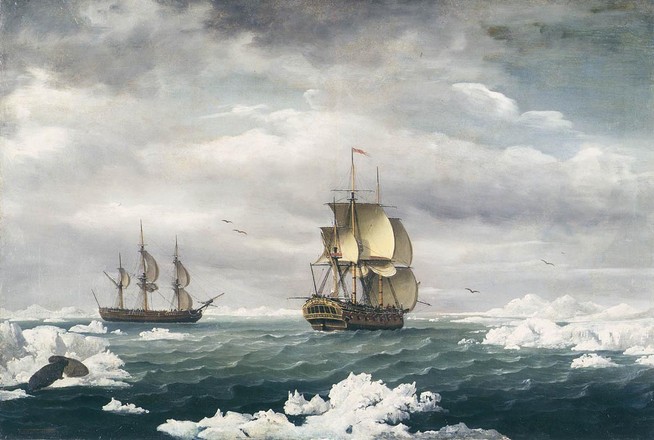The
genius of Captain James Cook was readily recognised by the Admiralty after the
first great voyage of discovery. Plans were made almost immediately for a
second voyage - this time to make a complete circumnavigation in the high
Antarctic latitudes.
Cook
had very vivid memories of near disaster while sailing through unknown waters
and his choice of ships was accepted by the Admiralty who were very conscious
of the magnitude of the undertaking.
The
Navy Board purchased two vessels, the Marquis
of Granby and the Marquis
of Rockingham. Both were similar types to the Endeavour but were not really
barks or barques. They could have been classed as ship-rigged sloops-of-war and
were built by Thomas Fishburn in 1770 at Whitby. They were commissioned under
the names of Drake
and Raleigh. Lord
Rockford, Secretary of State, thought the names might offend the Spanish and
consulted both the King and the Earl of Sandwich. The Earl advised him they
were to be renamed the Resolution
and Adventure.
The
Resolution impressed
Cook greatly and he called her "the ship of my choice", the fittest for
service of any I have seen". She was 14 months old and her tonnage of 462
was 100 more than the Endeavour.
She had the same flat-floored, apple-cheeked hull as the Endeavour.
Her
dimensions were:
- Lower deck length: 110 ft 8.inches (33.731m)
- Keel: 093 ft 6.inches (28.499m)
- Maximum beam: 035 ft 3 ½ inches (10.757m)
- Maximum depth: 013 ft 1 ½ inches
(4.0005m)
She
was fitted out at Deptford with the most advanced navigational aids of the day,
including a Gregory Azimuth Compass, ice anchors and the latest apparatus for
distilling fresh water from seawater. Twelve carriage guns and twelve swivel
guns were carried. At his own expense Cook had brass door-hinges installed in
the great cabin.
The
Resolution cost the
Admiralty £4,151. It was originally planned that Joseph Banks with an
appropriate entourage would sail again with Cook. A heightened waist, an
additional upper deck and a raised poop or round house were built to suit
Banks, but the ship was found to be top heavy in short sea trials. Under Admiralty
instructions, the offending structures were removed. Banks refused to travel
under "adverse conditions" and was replaced by Johann Forster and his
son, George. The conversion bill had cost a further £6565.
Her
complement when she sailed from Plymouth on 13 July 1772 was 112, and this
included 20 volunteers from the Endeavour. On her second voyage (Cook's third
voyage) she again carried 112.
On
his first voyage Cook had calculated longitude by the usual method of lunars
but on her second voyage the Board of Longitude spared no expense. It sent
William Wales, a highly qualified astronomer, with Cook and entrusted a new
chronometer, recently completed by Larcum Kendall (K1), together with three
chronometers made by John Arnold of Aldophi. Kendall's K1 was remarkably
accurate and was to prove to be most efficient in determining longitude on
board the Resolution.
The
Resolution was
responsible for some remarkable feats and was to prove one of the great ships
of history. She was the first ship to cross the Antarctic Circle (17 January
1773) and crossed twice more on the voyage. The third crossing on 3 February
1774, was the deepest penetration: Latitude 71° 10' South, Longitude 106° 54'
W. As a consequence the Resolution
was instrumental in proving Dalrymple's Terra Australis Incognita (Southern
Continent) to be a myth. On his third voyage, Cook in the Resolution crossed the Arctic
Circle on 17 August 1778. Charles Clerke, who took over the command after
Cook's tragic death again crossed it on 19 July 1779.
The
Resolution was back
in England in 1780. She was converted into an armed transport and sailed for
the East Indies in March 1781. She was captured by De Suffrens squadron on June
9, 1782. His journal states he was joined by the Sylphide and her prize the Resolution, a ship made famous
by the voyages of Captain Cook.
After
the action at Negapostam, the Resolution
was sent to Manila for wood, biscuit and rigging, and to enter any seaman she
found there. She sailed on July 22, 1782 and on June 5, 1783 De Suffren
expressed a notion that she had either foundered or fallen into the hands of
the English and was last seen in the Straits of Sunda. An extract from the
Melbourne Argus, February 25, 1879 says that the Resolution ended her days as a Portuguese
coal-hulk at Rio de Janeiro, but this is unconfirmed. In the possession of
Viscount Galway, a Governor-General of New Zealand, is a ship's figurehead
described as that of the Resolution.
A photograph of it does not agree with the figurehead depicted in Holman's
watercolour.
It
was zeal and resolution, which kept Cook at his tasks and helped him surmount
so many obstacles. It is so befitting the man that such a noble ship of his
choice should have been called the Resolution.
There
are 57 stamps issued which depict the Resolution,
and there is no doubt this number will be greatly increased by the anniversary
of Cook's death. The 1968 Cook Island issue is a beautiful set, but for sheer
atmosphere my choice is the 1973 Norfolk Island 35c stamp issued for the
Bicentenary of the First Crossing of the Antarctic Circle. It has been adapted
from a watercolour by William Hodges.



 Back to list
Back to list